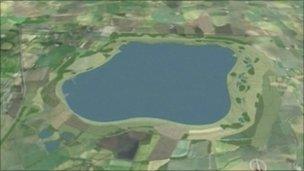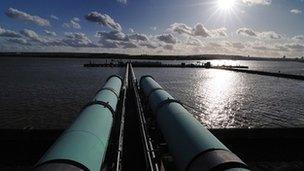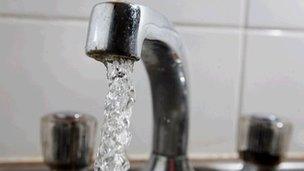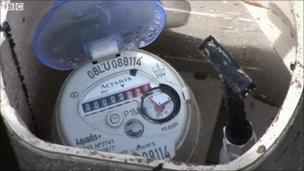Eight radical solutions for the water shortage
- Published

With hosepipe bans imminent, there is growing concern over drought in parts of the UK. But with population rising, how can a water crisis be averted?
After two unusually dry winters - which have left reservoirs, aquifers and rivers below normal levels - seven water companies across southern and eastern England are about to impose water restrictions.
If the dry weather continues during spring, the Environment Agency (EA) has warned the drought could spread.
The dire warnings bring back memories of 1976 - a year synonymous with sun, widespread water rationing and standpipes in the streets.
But experts say population growth and climate change could spell a much grimmer future.
The Office for National Statistics predicts the population of the UK will rise by 10 million in the next 18 years - reaching 71.4 million by 2030, and 78.4 million by 2050.
Climate change projections for the UK also suggest that by the 2050s summer temperatures will increase and summer rainfall will decrease.
The worst-case scenario, according to the EA, is that total water demand in England and Wales could increase 35% by the 2050s.
Nicola Poole, manager for water resources access and allocation at the agency, says climate change projections, which indicate the temperature may rise by 1.3C to 4.6C across southern England by 2050, would lead to an 80% decrease in summer run-off water - gatherable rainfall - available.
It would also leave half of the river basins across England and Wales deficient during the summer months.
The scenarios are made up of complex social and economic assumptions, and the projections are not definite, Poole says.
The Scottish Environment Protection Agency (Sepa) and Northern Ireland Water say they have no short-term concerns about the current water storage situation, but Sepa says it is working on long-term projections.
But what radical steps can be taken to stop the water crisis?
Spend billions on reservoirs
One way to tackle temporary shortages is to keep more stock and that means more reservoirs.
Water companies have been keen to build new reservoirs for years, but permission from the authorities has not always been forthcoming, with the government instead demanding companies reduce leakage.
Dr Keith Weatherhead, a water resources specialist at the Cranfield Water Science Institute, says there has been antipathy towards building new reservoirs.

Thames Water's computer-generated image of how the Abingdon £1bn reservoir would look
"Thames Water wanted to build a £1bn reservoir in Abingdon, Oxfordshire, but the plans were rejected by the government. Anglian Water has also toyed with it in the past.
"The water companies are keen, but Ofwat and the Environment Agency don't seem to be," he says.
That may be about to change though, as earlier this year, Environment Secretary Caroline Spelman pledged that changes to the planning system would make it easier to build reservoirs.
The EA says a number of new reservoirs are planned for after 2020 in southern England.
However the downside of reservoirs is they take a long time to plan and build, and come at a cost. Critics also argue they damage the environment and can create a substantial carbon footprint.
Colin Green, professor of water economics at the University of Middlesex, says part of the problem with reservoirs is they are a huge investment, and it is hard to predict how things will change in the next 40 years.
"We built a lot of reservoirs in the 1960s in expectation of a lot of growth in industrial water consumption, which didn't take place.
"We don't really want to build a lot of reservoirs now and then find we just spent hundreds of millions of pounds and the water sort of just sits there looking nice and we using it for boating," he says.
Start drinking salt water
For an island country, one possible solution is obvious. Desalination, or the process of converting salt water to drinking water, might seem a sure-fire solution.
Thames Water opened the first large-scale desalination plant in London in 2010. The £270m London facility was opened as a safeguard against water shortages like those in 2005 and 2006, and can supply 400,000 homes or 1m people with water.

The Beckton desalination plant can supply 150 million litres a day
But the plant is only operational during periods of drought because of the costliness of running it, according to Green.
Desalination remains a "very expensive, very power hungry" process, according to Jacob Tompkins, managing director of Waterwise, an organisation focused on decreasing water consumption.
"We can always engineer water, we can build desalination plants all around the coast, but the cost and carbon impact would be huge."
Water is "heavy and incompressible, so if you start pumping it uphill, you pay lots of money", Green adds.
Even after the water has been purified there's the remaining challenge of what to do with the leftover salt.
"We'd have to get rid of all the salt, would it be dropped back into the sea?" Tompkins says.
The WWF also warns large-scale seawater desalination could endanger marine life and is calling for further research into the tolerance of marine organisms and ecosystems to higher-salinity and brine waste.
Drink sewage water
It may not be as sexy as transforming sea water or building a cross-country conduit, but runoff from dirty dishes, lukewarm baths and toilet bowls holds promise - with a few caveats.
According to Ellis, waste water is perfectly drinkable after passing through a treatment plant.
"Literally you can dip a glass in and drink it, not saying I would, but you can do it," he says.
In fact, it's already done all over the world. But public perception is largely against the idea, Ellis says.
"It's psychological, so it's not a problem with the quality. The quality is superb, but psychologically it's not where people want to go."
Adrian McDonald, professor of environmental management at the University of Leeds, agrees.
"There's a philosophical concern, which I would share, that people really don't like washing or drinking water that has come from someone else's toilet, no matter how much science has said it's perfectly pure," he says.
And the cost of cleaning the water presents another challenge, according to McDonald.
"Yes, you could treat dirty water back to a potable standard, they do that in places like Singapore, but energy prices are increasing all the time, and it's quite costly to treat dirty water."
But Ellis contends that it wouldn't take much, psychology aside, to convert the country to using reclaimed water. Water treatment is happening anyway, so the only new cost would stem from diverting the purified water from rivers, where most of it goes now, to reservoirs and other water storage areas.
In 2006 John Lawson of the Institution of Civil Engineers touted waste water as particularly promising. "Effluent water reuse is still a relatively untapped way of providing drinking water to meet growing long-term needs," he said.
And for Ellis, a change in weather could be all it takes. "Who knows? With the droughts maybe public perception will change," he says.
Persuade people to use less water

Small actions like turning off the taps during washing up could save a considerable amount of water
British people use a lot more water than some of their counterparts in Europe, Tompkins says.
"In Britain we use an average of 150 litres per day, whereas in Germany and France they use 125 and 110 litres per person per day. Denmark is as low as 100. On that basis, we are wasting a third of water," he says.
Small steps like turning off the tap while brushing teeth would save huge amounts of water, he says. "A [typical] tap runs at six litres a minute - if people brush their teeth for two minutes, twice a day, that's 24 litres that goes down the sink. If everyone cut two minutes off their shower time, in one day they would save enough water to fill 373 Olympic swimming pools," he says.
Failing to act will leave the UK in the same situation as Australia and Cyprus, who have to look at water restriction on a regular basis, he says.
The EA says managing demand could account for about a third of the solution.
Compulsory water meters and raise prices
Using meters to monitor just how much water people are sending down drains, flushing in toilets and pouring over gardens promises to cut consumption, according to some experts.
Proponents say metering is the fairest way to charge for water and contend that people need to be held accountable for what they use.
It is an idea favoured by the government - which is optimistic that water meters can reduce the average water usage per person from 150 litres to 130 litres per day by 2030 - and supported by the EA, which says homes with meters use 10-15% less on average than those without them.

Water meters have been fitted in all new homes since 1990
All homes built since 1990 are fitted with water meters, and in 2008 one-third of domestic properties in England and Wales were metered. According to Water UK, the number is expected to increase in water-stressed regions to 80% by 2020 and 90% by 2030.
Tompkins says full metering is the way forward.
"A family of four uses as much in a day as a sprinkler uses in an hour. If people are using a sprinkler and swimming pool, then they need to pay for that," he says.
But charging people by usage doesn't always have the intended effect, according to Christopher Spray, chair of water science and policy at the UNESCO Centre.
"The assumption is that if you meter it, people will use less, but it doesn't necessarily always follow quite the way you think.
"Ironically, if you start metering people, their response is to say, 'Well, I'm paying for this, and I've got a lot of money so I'm going to use exactly as much as I want'."
A report by accountancy firm Deloitte, entitled Water Tight 2012, agrees that tiered pricing is the way forward.
It concludes the true value of water is not adequately reflected by the current pricing, but concedes that increasing water prices is always going to be a difficult political decision as domestic water usage is considered a basic human right.
Make companies fix leaky pipes
It is well documented that millions of litres of water are lost every day through broken and leaking pipes.
In 2009-2010 alone, the water industry in England and Wales leaked approximately 3.28 billion litres per day, according to industry regulator Ofwat. However the current levels are 35% lower than their peak in the mid-1990s.
"There will be some water companies that certainly are losing up to 40% of their final product in leakage through pipes, and there will be no-one doing better than 15%, at the very, very best," Spray says.
For Adrian McDonald, an environmental management professor at the University of Leeds, the amount of leakage from customers' pipes is "ridiculous", and plugging up these holes is a much more economical alternative to pumping water from across the country or raising water prices.
But there may be one beneficiary of the leaky-pipe phenomenon.
"Ironically, quite a lot of urban trees might die if all these pipes were perfectly sealed," Spray says.
Build a cross-country pipeline
For some experts the answer still lies in the much debated idea of channelling water from the north, which generally sees more rainfall, to the currently drought-stricken South East - via pipeline.

Millions in south and eastern England are facing hosepipe bans from Thursday 5 April
"Since Scotland and Wales are on the whole higher up than England, it is surely time to do the obvious; use the principle of gravity to bring surplus rain from the mountains to irrigate and refresh the breadbasket of the country in the South and East," he writes.
As recently as 2006, the Environment Agency issued a report to address the question: "Do we need large-scale water transfer for south-east England?" The report's conclusion? No. The cost was simply too high.
The most extreme proposal, five parallel pipes constructed between the northern Pennines and London, would cost between five and eight times more than building more infrastructure in the South East, it said.
But McDonald still sees a long-term solution in linking water companies across the country. More specifically, McDonald says connecting Northumbrian Water, with England's largest man-made reservoir, to Yorkshire Water, in the north, Severn Trent Water, in central England, and Thames Water, in the South East, would optimise the use of water resources.
"The reality is the people are in the South East, and our water resources are in the North.
"If you take every reservoir and every lake in the whole of England and Wales, all of the Lake District, and so on, and start pouring that into Loch Ness in Scotland, you'll only fill half of Loch Ness," he says.
Stabilise or move population
A large part of increasing demand for water in England and Wales will be down to increasing population.
When the ONS forecast that UK population would rise to 73.2 million by 2035, it noted that over two-thirds of the projected increase is either directly or indirectly due to migration.
The pressure on key infrastructure like water represents one argument for significantly reducing immigration, says Sir Andrew Green, from the Migrationwatch pressure group.
Immigration is also disproportionately to the South East of England, one of the areas already at risk from water shortages.
An alternative to reducing immigration would be encouraging long-term population transfer from parts of the UK like the South East of England that suffer shortages to those, like the North West or Scotland, that are less susceptible.